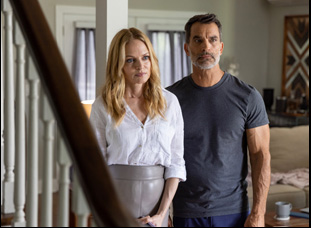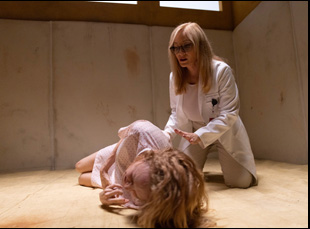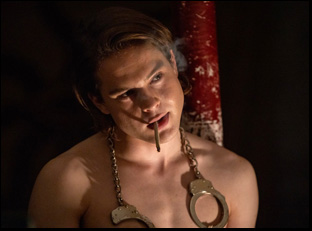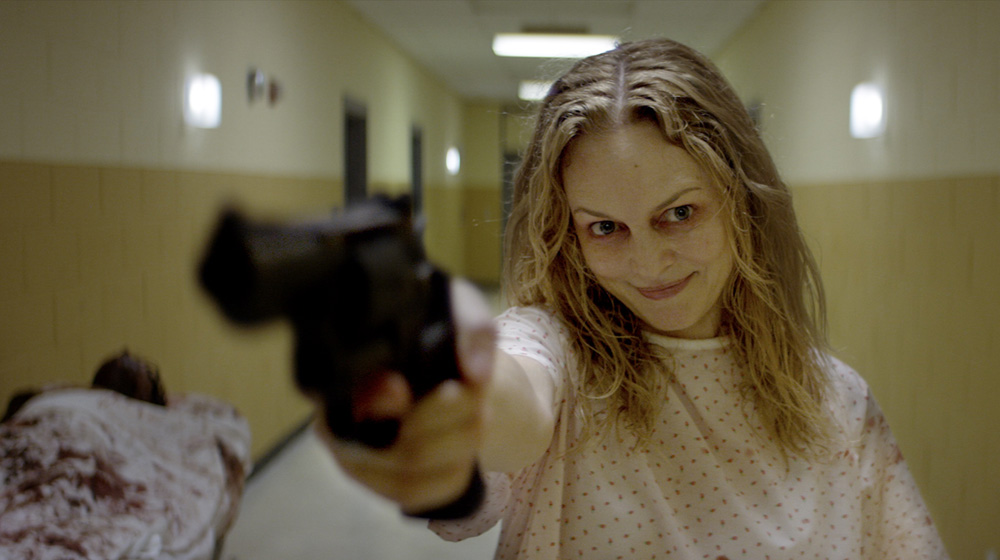“Believe me, there was a lot more salacious cinema that was on here before that we’ve watched and erased and have moved on from there,” Joe Lynch tells me as I peer into the background of his office over Zoom, seeing a blackboard behind him where a list of movies he plans to watch in preparation for his next resides and it should be noted that Nagisa Oshima’s notorious 1977 erotic thriller “In the Realm of the Senses” is still not crossed off. (And somehow it sits comfortably next to comparably classy “Ghost of Mrs. Muir,” which makes total sense from watching one of Lynch’s films.) It does beg the question on earth might’ve passed through his eyes for “Suitable Flesh,” his gloriously unhinged return to the horror genre after working wonders in the action space such as “Everly,” Mayhem” and “Point Blank,” and while Lynch has never been extreme for the sake of being extreme, he has pushed the envelope with each successive film, not only in terms of the giddy craziness that he’s been able to put on screen for everyone’s enjoyment, but take his myriad influences one step further into a brilliantly original realm.
“Suitable Flesh” may be his most impressive film to date in that regard, dedicated to the late, great Stuart Gordon, who would’ve likely made it his fourth H.P. Lovecraft adaptation following “Re-Animator,” “From Beyond” and “Dagon” and one of the few to get the author’s mix of sexually charged sci-fi just right, working from scripts by Dennis Paoli each time out. Longtime Gordon collaborators Barbara Crampton and Brian Yuzna brought the project to Lynch, but to honor Gordon would not be to imitate him and the filmmaker has succeeded wildly on that front, making a delightfully lurid adaptation of “The Thing on the Doorstep” where seduction and repulsion become an irresistible mix. With Heather Graham knowing exactly what the assignment is playing a psychiatrist named Beth, who takes on a troubled new client named Asa Waite (Judah Lewis) against her better judgment, “Suitable Flesh” starts out with her being held under observation at a mental asylum, diagnosed as a paranoid schizophrenic. She had no such symptoms prior to meeting Asa, who looks to get out from under the thumb of an abusive, well-to-do father (Bruce Davison), but as the two become both professionally and personally entangled, unspeakable and potentially supernatural things are passed between them that Beth now has to try and exorcise, with her friend and colleague Daniella (Crampton) unsure if she’s helping or harming her by keeping her lock and key.
Part of the great fun of “Suitable Flesh” is feeling that sense of discovery that you’d have stumbling upon it late at night when it’s in heavy rotation on cable when any random five minutes will have you hooked, but Lynch and his crew make the most of the big screen experience, exhibiting the kind of showmanship with surreal scene transitions and crafty camerawork that now seem like a lost art, all with Graham burning up the screen as her character burns down her life with a torrid affair and seeing its consequences come to life in unexpected ways. With the film making its debut this week at Tribeca — and en route to Fantasia Fest next month — where it’s already proved to be a queasy crowdpleaser, Lynch spoke about how he could make something of his own while paying tribute to Gordon, the greater restrictions of filming blood-splattered scenes inside historical landmarks and the sensitivities involved in getting the film’s more intimate moments just right.

When you talk about meeting your heroes, sometimes people say don’t, [because] they’ll disappoint you. But I met Stuart at one of the Masters of Horror dinners years ago and to already be surrounded by your heroes — Tobe Hooper, Wes Craven, and there’s John Landis and Joe Dante, and then Dario Argento shows up, and why is Michael Mann here? Holy crap. But Stuart sat down and he immediately launched into talking about movies — not his own movies, not my movies, but funny enough, we were talking about “Buried” with Ryan Reynolds, [which] he had really liked. We immediately just became friends and it was nice to be able to be like, “Hey, Stuart,” at the Hamburger Hamlet or whatever, and then later on him saying, “Hey, I liked your movie,” [where] I was like, “Whoa, holy crap.”
When we lost him a couple of years ago, I feel we truly lost someone that was pushing cinema in a way that it needed to go, and then it’s like, “Dammit,” because he was doing that all the way to the end. So when Barbara came to me with the script — and as slick as Barbara Crampton is, she’s the perfect producer too because she knows how to get a filmmaker interested in something by saying like, “Our dear friend, Stuart Gordon, had this script, he’s been trying to make it for years and when he knew that he wasn’t going to be able to do that, we asked, who would you want to do the film?” And then supposedly he said my name, so when you hear that, you’re just like, “Oh, fuck. I guess I have to read this script. I was incredibly excited because Stuart was a major influence on me as a filmmaker, whether you see it or not in the previous films that I’ve done. He was one of those filmmakers that knew how to balance tones in a way that I had never seen before.
When my mom rented “Re-Animator” for me — and she hates when I say that, but it’s true — and then “From Beyond,” I had not seen a film or a set of films that balanced terror and sexuality and humor in a way that felt like it wasn’t like switching channels on a TV, but it all felt very much like it was balanced within the story. It gave you a little something for everybody in a way. It allowed you to say, that is one of the most disturbing things I’ve ever seen. Why am I laughing? Or why am I feeling kind of funky down there? That [mix] was interesting, and Stuart was one of the first filmmakers that taught me that and I felt like he had done that all the way to some of his later films. So that was one of the main things that I wanted to hone in on as we were developing the script. The more that we talked about it to other people, it felt like, “Wow, there’s so many other people who love Stuart and love his work, why wouldn’t we want to make this a bit of a love letter to him,” the same way that DePalma did with Hitchcock back in the day. That felt like a very important touchstone for us to at least start with, and then we went from there.
In a practical way, what did that mean for way you filmed? There’s so many shots to get at all those competing impulses, the amount of camera set-ups must’ve been crazy.
It was a lot of prep, and thankfully when we had about a year-and-a-half developing and we also had the pandemic, [which was] unfortunate, but one of the bright sides was that [as] it put everybody at a standstill, you could still think about these ideas, so even in our safe little bubbles, [we’d] develop the script more. And after doing “Point Blank,” which was a much more sizable production, I wanted to be able to do things that I wasn’t able to do on that one and get back to horror, but also not have 17 cooks in the kitchen too. Thankfully, the producers, including Barbara and Bob Portal, really trusted me in being able to do that and one of the things that you can do to gain trust with your producers is come incredibly prepared.
And Stephen, I will never probably show these [storyboards publicly] — I am a terrible artist, but I can trace really well, so I storyboarded all the major sequences, especially a lot of the transitions that we had done and a lot of the more violent set pieces. And what my [writing] partner and I would do is take pictures and then I would trace over them and then present them as storyboards, so everyone would go, “Wow, oh my God, you’re such a good artist.” I’m like, “Oh, sure, yeah, that’s it.” [laughs] But ultimately, it is to be able to get the amount of setups that we did and to be able to get the kind of coverage we did on such a short schedule and with the parameters that we had. It [allowed us to] be able to go in guns blazing, knowing exactly what I needed, fully prepared, but also prepare to throw it all out because there were so many times where you’ll be like, “Alright, everybody, let’s do this” and then you find out it’s raining or an actor didn’t show up or that prop is gone now and someone stole it. Or you have an actor that’s like, “I’m not going stand there, why would I stand there?” And then all of your masterful Spielbergian shots are all just thrown into the wind. You have to be able to improvise. And thankfully I had such a great crew that was able to roll with the punches with me, but also contribute to making it better, so it’s a bit of a fusion or absolute preparedness and pure improvisation, which is perfect for this kind of movie.

Yeah. To be honest, it was a lot of faith because I had known that Heather had done a lot of films that in her past filmography that would be considered provocative and we needed to make sure that we had actors who felt comfortable being able to do this and we walked through everything with them. With Heather, she was like, “I’m game, let’s go.” And that was because we had created a mutual trust between each other. Then with Judah, most people know him from the “Christmas Chronicles” or “The Babysitter” movies, and after five minutes within meeting him, I knew that this was our Asa, but he also was very aware of the sexuality of it. Again, it all comes down to communication being incredibly clear.
When their lawyers came to us and said, tell us exactly how you’re going to shoot this because they’re protective of their clients, I totally got it. Thus, I created a 34-page document on every single angle, every lens — I even took pictures of myself in those positions. You will never see those pictures, but only to illustrate and make sure that everyone is 100% clear on what we’re doing so that there’s no discomfort at all. Then a lot of times, it was just the actors going, “Let’s just go for it,” [which] was an amalgam of trust of me, but also trust in each other and that was so important because those actors, if they don’t have trust in each other, very much like sex itself, sometimes when there isn’t a trust there, things can turn dark and dangerous and that’s something that I didn’t want on the production side of it. I know that we were getting very provocative with the sexuality in the film, but I wanted to make sure that everybody felt incredibly with it and comfortable and trusting and without them, we wouldn’t have the scenes that we do.
Something else I imagine you had to be careful with was the location that’s the Waite House in the film — I don’t want to spoil what happens there, but when it’s a designated historical landmark, what kind of restrictions were in place for the kinds of horrific scenes you were going to shoot?
It was so hard trying to find locations because we were trying to replicate the feel of the Northeast because it takes place in a very Lovecraftian kind of Massachusetts town like Arkham. We shot in Mississippi, and that was one of the few houses that actually felt like it would be in a Lovecraft story. It had a very gothic feel to it, and I had to have it, and the producers did their goddamn best to try to make sure that it was as cool as possible to shoot there. It wasn’t until we actually got in there that I realized, “Holy crap, I can’t spray blood anywhere.” That said, we did, but that’s a testament to our production being in a lot of plastic wrap because there were times where it’s like, “Alright, so the blood’s going to be here,” and they’re like, “No, no, no, no.” I’m like, “Well, it has to go here because we shot that side and we have to go this way.” And they’re like, “Get us a shitload of tarp.” And they’re putting tarp up everywhere. Thankfully, we left it in as good a shape as we came in with, but it was not easy. And nothing on this film was easy to do, but if it was easy, then what’s the fun in it? Sometimes the struggle makes it all worth it.
When you’ve got all these tones, the score really ties it all together as well. What was it like working on the music with Steve Moore?
I had worked with Steve Moore on “Mayhem,” and he’s in this great electronica band called Zombie. They’re two guys who use a lot of synth, so it’s very synthwave, and when it came for “Mayhem,” it fit perfectly with that. Plus I was a huge Zombie fan, so I wanted to work with him. But over the years, he had always expressed how he wanted to do something a little more classical and knowing that we were going for a slightly more orchestral feel, combine Bernard Herrmann with a little Pino Donaggio, but also even Jerry Goldsmith in “Basic Instinct.” We wanted that classical feel, Steve Moore’s not the first person that you would probably think of, but after a lot of back and forth and convincing my producers that this one man band could essentially do this whole thing, we set Steve to work.
I’m biased, but I think it’s Steve’s best score because very much like how this film pushed me because I had never done a movie like this before, this project pushed Steve to places that he had never gone before. When I was getting these tracks back, I’m going, “I’ve never heard anything like this, especially from this artist.” You add a little sexy sax in there and you can’t go wrong. But Steve got the movie, and he got where we needed to take it, and he pushed himself in a way that I have never seen an artist push themselves before and I’m so proud of it, I know he is too.

Any movie that gets made is a miracle and any film that you can see on any screen, especially with an audience is an even bigger miracle. Truth be told, this was a film that was very close to me and to so many of the people that worked on it. It took a long time to get to the screen. And it was a difficult shoot in that we only had a certain amount of time and money. Everyone who worked on it was great, but it was a struggle to get it to where it needed to be in the best ways. It pushed us creatively, so to be able to finally see it start to resonate — because when you’re making a movie, you sit there in a bubble going like, “Oh God, I hope people like this,” especially between the writing of it, the shooting of it, the editing of it, and then slowly getting it out there — just the response to the footage that we’ve shown and the poster that’s come out, and then to be able to watch it in my hometown with my mother sitting next to me, which is going to be very interesting [laughs], it is a dream come true. Not to say that that’s the reason why we make movies, but this is a movie that I hope will provoke people in the best ways. I’m not trying to piss anybody off, but I think this is the kind of movie that you want to see in a theater with a crowd to hear them scream, to hear them laugh, to hear them go, “Oooooh…” — a little everything. It’s a bouillabaisse of emotions that hopefully this movie will elicit from the audience, and this is the sort of thing that I would hope if I was Stuart Gordon, or Brian De Palma or Paul Verhoeven, and they snuck into a theater in 42nd Street and saw one of those crowds see their movie, this is what we’re hoping for.
“Suitable Flesh” will screen at Tribeca Festival on June 16th at 9:30 pm at the Village East. It will be distributed later this year by RLJ Films.




